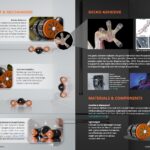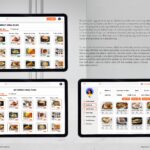As we wrap up this design project, our teamwork and innovative approaches have led to a successful outcome. We navigated each phase of the project, from initial concept to final execution, ensuring that every detail met our high standards. The following are the deliverables from our design project, LUMO, showcasing the collaborative efforts of our final week. The folio below includes comprehensive documentation of the design process and detailed deliverables.

MyView: Prototype Output
In our last post, we introduced two exciting solutions under the LUMO initiative. The first of these is MyView, a small autonomous robotic device designed to scan and monitor food items inside the fridge. MyView is equipped with VISIR2 and HYLIGHT technologies, providing real-time visuals of the current stock in your fridge. It can scan through both opaque and clear materials, such as plastic and glass food containers and bottles, to assess volume and quality. This facilitates better food stock and ingredient management while also detecting harmful bacteria and early signs of moisture that can lead to mold or spoilage.
To better present this idea, we created a 3D model of MyView and produced a physical prototype using PLA plastic material through 3D printing. We made two different sizes: one at actual scale, similar to the size of a Hot Wheels toy car, and a larger 1:5 scale version to showcase more detailed features. We spray-painted the prototypes in our team’s classic orange color and hand-painted blue details. Additionally, we installed a Raspberry Pi camera in the larger scale model to demonstrate how our device might operate in action.

MyFood: Software Layout
The second solution is MyFood, an adaptive and responsive software designed to reduce household food waste. It features self-training AI technology to help families manage their food efficiently. While MyView continuously monitors items and ingredients, providing real-time status updates, it communicates this data on food quality and quantity with MyFood. These two systems work hand-in-hand, ensuring the software has accurate and up-to-date information about the user’s food inventory, including items nearing expiration. This integration allows for better food management and reduced waste.
Our team designed a sleek and intuitive layout for the MyFood software, showcasing how it will look when fully operational. We created different pages where users can view their weekly meal plans, receive personalized food recommendations, and manage their grocery lists for upcoming supermarket visits. Additionally, we included features that notify users about updates on their food’s status, such as when items need to be consumed or have expired. Check out this link to test the MyFood software prototype! https://xd.adobe.com/view/300076bd-d143-42c1-9b9f-09600836d0e2-6553/?fullscreen

Update: LUMO Implementation Strategy
After carefully creating an initial roadmap, we worked on refining it to ensure its alignment with our evolving technological vision. We wanted to not only map out our tech’s direction but also understand emerging trends, market changes and what users need. Each adjustment helped us make the roadmap more practical and better able to navigate the changing world of innovation.
Previously, we had set the implementation strategy for the LUMO initiative to reach completion by 2080. However, we have now adjusted this timeline to 2060. This change comes after consultations with tech designer professionals who advised us that our solution is highly feasible and can be implemented sooner than we initially anticipated. This is a positive development for our team, allowing us to bring our solutions to market earlier than expected.


Throughout our project journey, we faced challenges that tested our critical thinking and pushed the boundaries of futuristic ideation, requiring radical thinking. Getting through these challenges wasn’t easy, but each obstacle presented an opportunity for growth and learning. We gained valuable insights that helped make our design solution successful.
As designers, we may not fully grasp the underlying science and mechanics, but through perseverance, adaptability, and a commitment to innovation, we have gained a deeper understanding of technology and how it can benefit the community. By trying our very best to sharpen our imagination and applying through our design research skills, we have developed ideas that we are truly proud of and these ideas demonstrate our dedication to applying technology in ways that challenge sustainability such as responsible production and consumption.
The problem of food waste is significant, but every idea we generate, whether simple or complex, futuristic or seemingly impossible, or even too expensive for immediate benefits, holds value. We have learned that all of these ideas are important and worthwhile because they contribute to our goal of creating a better planet. As responsible designers, we are proud to have thought of these solutions and believe each step brings us closer to a more sustainable future.
Our journey underscores the importance of resilience and the willingness to embrace daring and crazy ideas. It has shaped our minds to transcend limits and venture into vast possibilities and that made us BOUNDLESS & BEYOND!


















Recent Comments